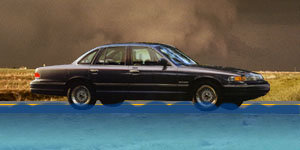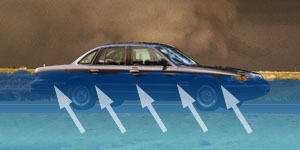
Preparing your home
Avoid building in a flood prone area unless you elevate and reinforce your home.
Elevate utilities like furnaces, water heaters, and electric panels. Have a licensed electrician raise electric components (switches, sockets, circuit breakers and wiring) at least 12" above your home's projected flood elevation.
Install "check valves" in sewer traps to prevent floodwater from backing up into drains.
Buy and install sump pumps with back-up power.
Seal basement walls with waterproofing compounds to avoid seepage.
Prepare your family
Plan and practice a flood evacuation route with your family. Ask an out-of-state/out-of-area relative or friend to be the "family contact" in case your family is separated during a flood. Make sure everyone in your family knows the name, address, and phone number of this contact person.
Post emergency phone numbers where they can be easily found.
Inform local authorities about any special needs, i.e., elderly or bedridden people, or anyone with a disability.
Identify potential home hazards and know how to secure or protect them before the flood strikes. Be prepared to turn off electrical power when there is standing water, fallen power lines, or before you evacuation. Turn off gas and water supplies before you evacuate. Secure structurally unstable building materials.
Buy a fire extinguisher and make sure your family knows where it is and how to use it.
Emergency supplies you may need
You should stock your home with supplies that may be needed during the emergency period. At a minimum, these supplies should include:
Several clean containers for water, large enough for a 3-5 day supply of water (about five gallons for each person).
A 3-5 day supply of non-perishable food and a non-electric can opener.
A first aid kit and manual and prescription medicines and special medical needs.
A battery-powered radio, flashlights, and extra batteries.
Sleeping bags or extra blankets.
Water-purifying supplies, such as chlorine or iodine tablets or unscented, ordinary household chlorine bleach.
Baby food and/or prepared formula, diapers, and other baby supplies.
Disposable cleaning cloths, such as "baby wipes" for the whole family to use in case bathing facilities are not available.
Personal hygiene supplies, such as soap, toothpaste, sanitary napkins, etc.
An emergency kit for your car with food, flares, booster cables, maps, tools, a first aid kit, fire extinguisher, sleeping bags, etc.
Rubber boots, sturdy shoes, and waterproof gloves.
Insect repellent containing DEET or Picaridin, screens, or long-sleeved and long-legged clothing for protection from mosquitoes which may gather in pooled water remaining after the flood.
During a flood
If flooding is likely:
Monitor the media (television, radio, social media) for information
Be aware that flash flooding can occur. If there is any possibility of a flash flood, move immediately to higher ground. Do not wait for instructions to move.
Be aware of streams, drainage channels and other areas known to flood suddenly. Flash floods can occur in these areas with or without such typical warnings as rain clouds or heavy rain.
If you must prepare to evacuate:
Secure your home. If you have time, bring in outdoor furniture. Move essential items to an upper floor.
Turn off utilities at the main switches or valves if instructed to do so. Disconnect electrical appliances. Do not touch electrical equipment if you are wet or standing in water.
If you must leave your home:
Do not walk through flowing water: Drowning is the #1 cause of flood deaths, mostly during flash floods. Currents can be deceptive - six inches of moving water can knock you off your feet. If you walk in standing water, use a pole or stick to ensure that the ground is still there.
Do not let children play in flooded areas: Besides the danger of drowning or injury, a person can become very sick if the water is ingested.
Do not drive through a flooded area: Do not drive around road barriers; the road or bridge may be washed out or the water may be deep. A car can float in only about two feet of water. Passenger cars may float in 18-24 inches of water.
Don't drown, turn around- driving through flooded areas is extremely dangerous.

Water weighs 62.4 lbs. per cubic foot and typically flows downstream at 6 to 12 miles an hour.
When a vehicle stalls in the water, the water's momentum is transferred to the car. For each foot the water rises, 500 lbs. of lateral force are applied to the car.

But the biggest factor is buoyancy. For each foot the water rises up the side of the car, the car displaces 1,500 lbs. of water. In effect, the car weighs 1,500 lbs. less for each foot the water rises.
Just two feet of water will carry away most automobiles!
*Graphics and text developed by the City of Fort Collins, CO. Used with permission.
After a flood
Returning home
Return home only when authorities indicate it is safe.
Stay out of any building if it is surrounded by floodwaters.
Use extreme caution when entering buildings: there may be hidden damage, particularly in foundations.
Be aware of areas where floodwaters have receded. Roads may have weakened and could collapse under the weight of a car.
Avoid moving water.
Avoid floodwaters; water may be contaminated by oil, gasoline, or raw sewage.
Electricity and gas
Stay away from power lines and electrical wires: The #2 flood killer after drowning is electrocution. Electrical currents can travel through water. Report downed power lines to your local power company.
Have your electricity turned off: Some appliances, such as television sets and computers, keep electrical charges even after they have been unplugged. Don’t use appliances or motors such as in your washer or dryer that have gotten wet unless they have been taken apart, cleaned and dried.
Never enter a flooded basement unless you know the power has been turned off. The water level may be above the electrical outlets or there may be a submerged electrical cord.
Be alert for gas leaks: Use a flashlight to inspect for damage. Don’t smoke or use candles, lanterns or open flames unless you know the gas has been turned off and the area has been ventilated.
Cleanliness
Listen for news reports to learn whether the community’s water supply is safe to drink.
Throw away food: This includes any canned goods that have come in contact with floodwater.
Clean and disinfect everything that got wet. Mud left from floodwater can contain sewage and chemicals.
Service damaged septic tanks, cesspools, pits, and leaching systems as soon as possible. Damaged sewage systems are serious health hazards.
More information
